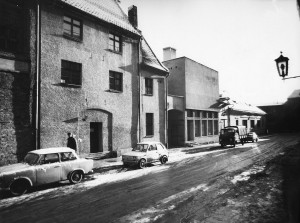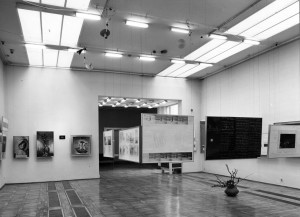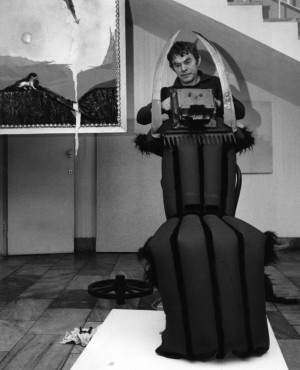History

BWA w Toruniu – nowo-wybudowany pawilon przy ul. Ducha Sw. – proj. gmachu Jan Tajchman, proj. wnetrza Henryk Sobczyk, w glebi widocza Wozownia
Wozownia Art Gallery has been around since 1950. In the years 1950-1961, the Gallery operated as the official representation of CBWA from Bydgoszcz (Central Bureau of Art Exhibitions) in Toruń, later, as the delegacy for Toruń of the Bureau of Art Exhibitions in Bydgoszcz (1962-1975). As of January 1st, 1976 the Gallery became the Bureau of Art Exhibitions in Toruń with its independent charter. The institution’s name was changed in 1992 to the National Art Gallery “Wozownia”. Its current statute and name, Wozownia Art Gallery in Toruń, have been in force since 2009.
Until 1957, the Gallery shared its headquarters with ZPAP (The Association of Polish Artists and Designers) in Dom Plastyka (Artist’s Home), later in “the Artus Court” by the Old Town Square, and since 1975, in the newly-built pavilion at ul. Ducha Św. 8/10 (exterior design: Jan Tajchman; interior design: Henryk Sobczyk). At present, the gallery is located in a historic building (the old Prussian artillery coach house) in the oldest part of Toruń, by the Holy Spirit Gate, near the Old Town City Hall, Copernicus House and the Leaning Tower.

BWA pawilon przy ul. Ducha Sw
Between 1961-1968, the Gallery was directed by Teresa Frankiewicz; 1968-91 – Marianna Olechnicka; 1991-95 – Ziemowit Michałowski; 1996-98 – Zofia Karpińska. The current director of the Wozownia Art Gallery, since 21st December 1998, is Anna Jackowska, a graduate of Art History at Adam Mickiewicz University in Poznań (she received her degree in 1985) – she took office after winning the competition for the post (beforehand, between 1987 and 1996, she worked at Wozownia as a curator).
Not much of the documentation from the early expositions has survived till today. Although it is known that all Toruń-based artists presented their works (this was the tradition and obligation at the time) as part of individual or group exhibitions (including anniversary displays of Stanisław Borysowski for his celebration of 30 and 40 years of artistic activity, or Barbara Narębska-Dębska for her 25th anniversary of work in art), also expositions of artists and artistic groups from other centers were organized: for instance, in 1959 an exhibition of the Cracovian Group was arranged (including Jonasz Stern, Maria Jarema, Kazimierz Mikulski among others).

wystawa malarstwa Marka Zulawskiego 1968
The Gallery hosted solo shows of such artists as: Jerzy Pank (1958), Jan Szancenbach (1960), Józef Gielniak (1961), Eugeniusz Markowski (1962), Jerzy Jarnuszkiewicz (1966), Leszek Rózga (1967, 1971), Konrad Srzednicki (1971), and in the year of 1973 alone, one could admire the works of Jan Dobkowski, Zbylut Grzywacz, Jerzy Nowosielski, Bronisław Chromy.
A magnificent and memorable exhibition of Władysław Hasior took place in 1977, as did the exposition of Józef Szajna’s stage designs. The presentations were remembered due to enormous participation rates.
Solo shows of artists from abroad were rather infrequent. If they did happen, these were usually less famous artists, although in 1968, the Gallery displayed paintings by Marek Żuławski from London. Moreover, through cooperation with councils, embassies and British Council we were able to show, for instance, contemporary British stage designs (1981) and an exhibition entitled “The 1970s: New American Painting” (1980), which was shown in Toruń first and then only at the National Museum in Warsaw.
As for the individual exhibitions in the period between 1976-1995 one should mention, among others, the display of Stasys Eidrigevičius – the career beginnings of this now-celebrated artist span over the expositions at the Gallery. Also, artists from Cracov, such as: Jerzy Nowosielski, Kazimierz Mikulski, Jan Szancenbach, Stanisław Rodziński, but also graphics by Ryszard Gieryszewski, Józef Gielniak, Leszek Rózga, the paintings of Ryszard Winiarski, Edward Dwurnik, Marian Czapla, the works of Jan Berdyszak, Stażewski; photographs by Edward Hartwig; sculptures of Bronisław Chromy and Ewa Olszewska-Borys’s medals; Eugeniusz Molski’s ceramic; glass art by Henryk Albin Tomaszewski, textile art by Jolanta Owidzka.
In the 1990’s there were unforgettable exhibitions, namely, the display of Paweł Frączkiewicz’s installations at Place Rapackiego in 1993, as well as, presentations of deceased artists, who worked in France, i.e. Roman Cieślewicz and Paweł Jocz, organized in the same year.
Amid the prominent figures of the contemporary art world that Wozownia has been exhibiting for the last couple of years, apart from the regular events, and as part of large-scale and significant solo shows, one could come across: Jan Berdyszak, Natalia LL, Heinz Cibulka, Ewa Blum-Kwiatkowska, Ewa Harabasz, Marcin Berdyszak, Izabella Gustowska, Aleksandra Ska. Lately, the Gallery has also managed to recycle people of great importance for the Polish art history, for example, Artur Nacht-Samborski, Lucjan Mianowski, Wojciech Bruszewski or Henryk Tomaszewski.
Regularly hosted events:
The First Polish Exhibition of Medallic Art entitled “The Child Theme in Medallic Art” was organized in 1979 and curated by Piotr Gawron. Its second edition – “To Peace” – took place in 1984, and the consequent editions: the third (1988) and the fourth (1991) came under the name “Trends and Creators”, their curators being Ewa Olszewska-Borys and Teresa Dudzińska respectively. The best of Polish medallists participated in the events, artists such as: Bronisław Chromy, Krystian Jarnuszkiewicz, Zofia Demkowska, Józef Markiewicz, Krzysztof Szczepan Nitsch, Stanisław Sikora, Stanisław Plęskowski, Adolf Ryszka; as well as authors from Toruń: Joanna Bebarska, Czesława Gucz, Iwona Langowska, Ryszard Mirowski, and Ewelina Szczech-Siwicka among others.
 The International Graphic Triennial “Color in Graphic Art”– the event is meant to present the output of prominent graphic designers (the artists receive named invitations from the Gallery) from all over the world, in whose works color is of crucial importance. The first four editions of the triennial (1982, ‘85, ‘88 and ‘91) gathered artists from across Poland. Its first international edition, in 1994, (curated by Jerzy Grabowski) was accompanied by an exhibition entitled “22 Protagonists – Trends of Concrete Art in Color Graphics of Our Century”. The latest editions of “Color in …” have been made more specific by the organizers (since color is no longer a unique attribute of any artistic practice): the participants are to answer the question concerning the status of graphic design ‘here and now’, in other words, whether the relation between tradition and identity has made the exhibitions more interesting not only for the fans of graphic techniques, but also for a broader spectrum of recipients. Selected works from the subsequent editions of the triennial were twice on display at The Thessaloniki State Museum of Contemporary Art in Greece. Wozownia is the only Polish gallery to regularly present color graphics at international thematic shows.
The International Graphic Triennial “Color in Graphic Art”– the event is meant to present the output of prominent graphic designers (the artists receive named invitations from the Gallery) from all over the world, in whose works color is of crucial importance. The first four editions of the triennial (1982, ‘85, ‘88 and ‘91) gathered artists from across Poland. Its first international edition, in 1994, (curated by Jerzy Grabowski) was accompanied by an exhibition entitled “22 Protagonists – Trends of Concrete Art in Color Graphics of Our Century”. The latest editions of “Color in …” have been made more specific by the organizers (since color is no longer a unique attribute of any artistic practice): the participants are to answer the question concerning the status of graphic design ‘here and now’, in other words, whether the relation between tradition and identity has made the exhibitions more interesting not only for the fans of graphic techniques, but also for a broader spectrum of recipients. Selected works from the subsequent editions of the triennial were twice on display at The Thessaloniki State Museum of Contemporary Art in Greece. Wozownia is the only Polish gallery to regularly present color graphics at international thematic shows.
 A slightly younger regular event, thet Triennial of Small-Size Painting (its first editions, between 1988-2007, were organized biannually), has received a lot of sympathy from both the artists and recipients. The single constraint applied here is the format of the works, thus, every 3 years at Wozownia, one can admire presentations of various trends in contemporary painting. The small scale allows displaying a greater number of works, which implies greater diversity in artistic attitudes than in the context of traditional review exhibitions of contemporary painting. Moreover, the small format calls for more focused and intimate reception – a feature particularly valued by the participants. The event is supervised by Teresa Dudzińska.
A slightly younger regular event, thet Triennial of Small-Size Painting (its first editions, between 1988-2007, were organized biannually), has received a lot of sympathy from both the artists and recipients. The single constraint applied here is the format of the works, thus, every 3 years at Wozownia, one can admire presentations of various trends in contemporary painting. The small scale allows displaying a greater number of works, which implies greater diversity in artistic attitudes than in the context of traditional review exhibitions of contemporary painting. Moreover, the small format calls for more focused and intimate reception – a feature particularly valued by the participants. The event is supervised by Teresa Dudzińska.
The youngest of the regular events is PERSONY (PERSONAS), organized together with the Poster and Design Gallery in Poznań. It is a cycle of exhibitions that present prominent international figures from the world of design: individuals, who influence our visual habitat. During Personas, Wozownia hosted such artists as Hans Hillmann from Germany, Ostvan Orosz from Hungary, Koichi Sato from Japan as well as the American duo Nancy Skolos & Thomas Wedel.
 Dedicated to the youngest artists, Wozownia created at its premises the Art Lab project: an example of a gallery within a gallery. Its formula consists of organizing a number of solo shows under one common slogan. Once a given cycle is finished, we publish a catalog presenting the confrontation between the works in the context of the initial problem posed.
Dedicated to the youngest artists, Wozownia created at its premises the Art Lab project: an example of a gallery within a gallery. Its formula consists of organizing a number of solo shows under one common slogan. Once a given cycle is finished, we publish a catalog presenting the confrontation between the works in the context of the initial problem posed.
The project is executed at Wozownia in a small room of unusual spatial characteristics. Hence many of the pieces created here were site-specific and they dealt with, on the side of both the artists and the curators, the relationship between the work of art and its location. Małgorzata Jankowska was the author of the first edition. Currently, i.e. since 2009, the project is managed by Maria Niemyjska.
Extra-exhibitional actions:
Since the Gallery’s launch, it has been organizing meetings with authors, art workshops for children and teenagers, contests, plebiscites. Forms of educational activities encompass:
-
Tournament in the knowledge of art, between 1976-81
-
Lectures in art history (in the years 1993-’95 delivered by Ryszard Depta; and before him: Janusz Bogucki, Bożena Kowalska, Danuta Wróblewska, Bogusław Mansfeld among others)
-
En plein air sessions and other similar activities – street shows of “Toruń’s Visual Arts” in 1978 and 1979; painting workshops “Image and Metaphor” in Górzno (curated by Jan Pręgowski)
-
Auctions of contemporary artworks – the first such event in Toruń was an auction of artworks on November 19, 1989 for the Prime Minister Tadeusz Mazowiecki’s Fund of Supporting Social and Economic Initiatives
-
Publishing house – posters, catalogs (at times also albums), portfolios
After the year 2000, the list has extended significantly at different levels and in different forms of interacting with art. What is meant here are various workshops, meetings, lectures and promoting events organized by the Gallery.
PresentAKCJE / PresentACTIONS (video art, multimedia art, performances, experimental films), between 2000 – 2006 managed by Małgorzata Jankowska; comprised of various events such as lectures by Ryszard Kluszczyński, Piotr Krajewski; multimedia presentations by Piotr Wyrzykowski, Dominik Lejman, Alicja Żebrowska; 2005 – Łukasz Ronduda – Polish Assembly Flims, One Day for Performances in 2005 (Sędzia Główny / Main Jury – Aleksandra Kubiak, Karolina Wiktor; Dziewczęta Przeszanowne / Respectable Girls – Marcelina Gunia, Karolina Stepniowksa, Natalia Turczyńska; Anna Gryczka, Angelika Fojtuch, 2006, among other, Cause&Effect – an interactive film spectacle (Chris Hales, premiere in Poland); Pąsowa Róża / Crimson Rose of Małgorzata Jankowska – films by Polish and German artists (Alicja Żebrowska, Ania Baumgart, Artur Żmijewski among others), screening of Azorro Group’s films – a meeting with Oskar Dawicki, Igor Krenz and Wojciech Niedzielko).
 „Architecture at Wozownia” – a series of lectures on topics in contemporary architecture – originated and lead by Teresa Dudzińska. The main aim of the project was, and still is, to show and familiarize the audience with the most interesting issues in contemporary architecture. The lectures are meant for all who find interest in architecture, want to understand its foundations and various trends, learn to perceive it better and to notice that architecture can be interpreted at many levels. Prominent architects, architecture critics and art historians are invited to take part in “Architecture at Wozownia”. The range of topics embraces both the theory, as well as the practice of architecture, showing its diversity and complexity. The organizers hosted such names as Hubert Trammer, Grzegorz Piątek, Szymon Kubiak, Roman Rutkowski.
„Architecture at Wozownia” – a series of lectures on topics in contemporary architecture – originated and lead by Teresa Dudzińska. The main aim of the project was, and still is, to show and familiarize the audience with the most interesting issues in contemporary architecture. The lectures are meant for all who find interest in architecture, want to understand its foundations and various trends, learn to perceive it better and to notice that architecture can be interpreted at many levels. Prominent architects, architecture critics and art historians are invited to take part in “Architecture at Wozownia”. The range of topics embraces both the theory, as well as the practice of architecture, showing its diversity and complexity. The organizers hosted such names as Hubert Trammer, Grzegorz Piątek, Szymon Kubiak, Roman Rutkowski.
„Art Seeks Simplicity” (launched in 2012) a cycle of workshops for children and teenagers accompanied by meetings at exhibitions. The aim of the project is to introduce the main tenets of contemporary art to the participants via active, creative actions. The cycle is to stimulate in the youth the ability to think synthetically and conceptually, and to make them aware that to develop their own works, they do not necessarily need numerous and various artistic tools. All of the events take place at the premises of the Wozownia Art Gallery and their contents reflect the theme of the exhibition currently at display. Kamila Krzanik-Dworanowska and Kazimierz Napiórkowski manage the events.
„A Project for …” (since 2014) is the youngest of the projects and it was conceived by Kamila Krzanik-Dworanowska. The plan involves meetings devoted to issues in contemporary design, understood as more than just approaches to external aesthetics of objects. We wish to draw the attention to the fact that design is a much broader discipline, present in our lives on a daily basis. We shall make an attempt to present the relation between design, art and commerce, as well as to discuss the social role of a designer. The greatest value of contemporary design is its ability to solve problems. Meetings with theoreticians and practitioners of design will bring the process of designing closer to the recipients from particular groups of interest. Two lectures took place in 2014: in June, we hosted Czesaława Frejlich, and in November, Magda Kochanowska – a researcher and theoretician of design.
wystawa Wladyslawa Hasiora 1977
Other lectures and meetings with prominent figures of Polish humanities, usually supplemented by promotion of latest publications – for instance, a meeting with Rene Block: Art, Life & Confusion (Marta Smolińska), Ewa Toniak “On a Few Masochistic Fantasies and Masculinity”. Other events included “Around Anna Baumgart’s ‘Warrior’”; Krzysztof Jurecki “In Search of the Sense of Photography”; Agata Jakubowska “‘Multiple Portrait’ by Alina Szapocznikow”; Luiza Nader “Conceptualism in Polish People’s Republic”; a discussion on Monika Bakke’s book “Bio-Transfigurations” with professors Andrzej Turowski, Piotr Piotrowski (”Agorafilia”), Ewa Domańska. “The Art and Aesthetics of Posthumanism” or “Film as Art” by Marta Kosińska; meetings with artists who trigger changes in today’s art, as, for instance, the meeting with Honorata Martin and Łukasz Surowiec. .
The nature of the Gallery has been changing along with the changes in art and in the functioning of an art institution, as well as in the organization of life – not only cultural life, but also social life in general. The history of art has gone in such a direction that the gallery, from being a place of art presentation, has become a place of art creation.
At present, Wozownia displays works of famous artists, yet it mostly a place for exhibiting young talents. This is why the Gallery in Toruń has such a unique status among the Polish art institutions. It does not consolidate a once-established hierarchy: it reaches beyond any fixed, closed group of artists by constantly searching for young authors. Thus, it focuses on promotion and experimentation.
